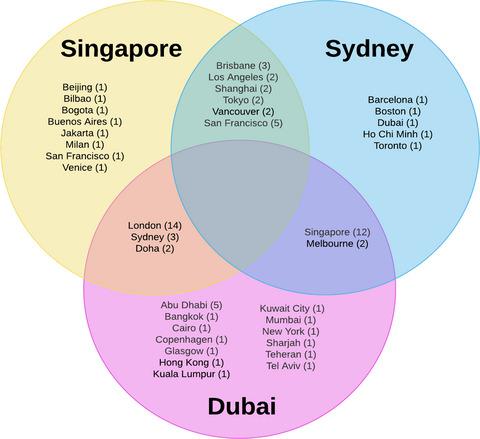Our official English website, www.x-mol.net, welcomes your feedback! (Note: you will need to create a separate account there.)
Shaping a global comparative imagination? Assessing the role of city rankings in the “global city” discourse
Area ( IF 2.057 ) Pub Date : 2021-03-21 , DOI: 10.1111/area.12710 Michele Acuto 1 , Daniel Pejic 1
Area ( IF 2.057 ) Pub Date : 2021-03-21 , DOI: 10.1111/area.12710 Michele Acuto 1 , Daniel Pejic 1
Affiliation

|
The last decade has seen “global” and “comparative” forms of urbanism flourish, and critiques thereof expand. While in theory the discussion on the value or shortcomings of global city thinking has thrived, in practice many cities have applied it through expanding international outlooks and collaborations through mounting numbers of partnerships and networks. This has also witnessed a growing sense of competition between peers near and far for investment, talent, and tourism. The “comparative gestures” of cities are increasingly common not just in research but in practice, with expanding ranks of city benchmarking to testify to the popularity of “actually existing” comparative thinking. While there has been a significant rise in the number of city rankings and indexes, as well as increased scholarly interest in comparative urban analysis, how benchmarking is shaping the imagination of those driving urban policymaking or indeed how it relates to global city thinking is still little understood. This study aimed to identify correlations between an appreciation of city rankings and “global city” thinking, especially in cities that have emerged on the “map” of global urbanism. It draws on 170 interviews with a variety of key urban development stakeholders in Dubai, Singapore, and Sydney, focusing on how city rankings relate to the ways we speak of global cities. It suggests a close but nuanced correlation between global city thinking and benchmarking in these cities, but also a wider “map” of comparative gestures than we may have anticipated.
中文翻译:

塑造全球比较想象力?评估城市排名在“全球城市”话语中的作用
在过去的十年里,“全球”和“比较”形式的城市主义蓬勃发展,对其批评也不断扩大。虽然在理论上,关于全球城市思维的价值或缺点的讨论蓬勃发展,但在实践中,许多城市已经通过越来越多的伙伴关系和网络扩大国际视野和合作来应用它。这也见证了远近同行在投资、人才和旅游方面的竞争日益加剧。城市的“比较姿态”不仅在研究中而且在实践中越来越普遍,城市对标的行列不断扩大,以证明“实际存在”比较思维的流行。虽然城市排名和指数的数量显着增加,并且学术界对比较城市分析的兴趣增加,基准测试如何塑造那些推动城市决策的人的想象力,或者它与全球城市思维的关系,仍然鲜为人知。本研究旨在确定对城市排名的欣赏与“全球城市”思维之间的相关性,尤其是在出现在全球城市化“地图”上的城市中。它借鉴了对迪拜、新加坡和悉尼的各种主要城市发展利益相关者的 170 次采访,重点关注城市排名与我们谈论全球城市的方式之间的关系。它表明全球城市思维与这些城市的基准测试之间存在密切但微妙的相关性,但也表明比我们预期的更广泛的比较姿态“地图”。本研究旨在确定对城市排名的欣赏与“全球城市”思维之间的相关性,尤其是在出现在全球城市化“地图”上的城市中。它借鉴了对迪拜、新加坡和悉尼的各种主要城市发展利益相关者的 170 次采访,重点关注城市排名与我们谈论全球城市的方式之间的关系。它表明全球城市思维与这些城市的基准测试之间存在密切但微妙的相关性,但也表明比我们预期的更广泛的比较姿态“地图”。本研究旨在确定对城市排名的欣赏与“全球城市”思维之间的相关性,尤其是在出现在全球城市化“地图”上的城市中。它借鉴了对迪拜、新加坡和悉尼的各种主要城市发展利益相关者的 170 次采访,重点关注城市排名与我们谈论全球城市的方式之间的关系。它表明全球城市思维与这些城市的基准测试之间存在密切但微妙的相关性,但也表明比我们预期的更广泛的比较姿态“地图”。关注城市排名与我们谈论全球城市的方式之间的关系。它表明全球城市思维与这些城市的基准测试之间存在密切但微妙的相关性,但也表明比我们预期的更广泛的比较姿态“地图”。关注城市排名与我们谈论全球城市的方式之间的关系。它表明全球城市思维与这些城市的基准测试之间存在密切但微妙的相关性,但也表明比我们预期的更广泛的比较姿态“地图”。
更新日期:2021-03-21
中文翻译:

塑造全球比较想象力?评估城市排名在“全球城市”话语中的作用
在过去的十年里,“全球”和“比较”形式的城市主义蓬勃发展,对其批评也不断扩大。虽然在理论上,关于全球城市思维的价值或缺点的讨论蓬勃发展,但在实践中,许多城市已经通过越来越多的伙伴关系和网络扩大国际视野和合作来应用它。这也见证了远近同行在投资、人才和旅游方面的竞争日益加剧。城市的“比较姿态”不仅在研究中而且在实践中越来越普遍,城市对标的行列不断扩大,以证明“实际存在”比较思维的流行。虽然城市排名和指数的数量显着增加,并且学术界对比较城市分析的兴趣增加,基准测试如何塑造那些推动城市决策的人的想象力,或者它与全球城市思维的关系,仍然鲜为人知。本研究旨在确定对城市排名的欣赏与“全球城市”思维之间的相关性,尤其是在出现在全球城市化“地图”上的城市中。它借鉴了对迪拜、新加坡和悉尼的各种主要城市发展利益相关者的 170 次采访,重点关注城市排名与我们谈论全球城市的方式之间的关系。它表明全球城市思维与这些城市的基准测试之间存在密切但微妙的相关性,但也表明比我们预期的更广泛的比较姿态“地图”。本研究旨在确定对城市排名的欣赏与“全球城市”思维之间的相关性,尤其是在出现在全球城市化“地图”上的城市中。它借鉴了对迪拜、新加坡和悉尼的各种主要城市发展利益相关者的 170 次采访,重点关注城市排名与我们谈论全球城市的方式之间的关系。它表明全球城市思维与这些城市的基准测试之间存在密切但微妙的相关性,但也表明比我们预期的更广泛的比较姿态“地图”。本研究旨在确定对城市排名的欣赏与“全球城市”思维之间的相关性,尤其是在出现在全球城市化“地图”上的城市中。它借鉴了对迪拜、新加坡和悉尼的各种主要城市发展利益相关者的 170 次采访,重点关注城市排名与我们谈论全球城市的方式之间的关系。它表明全球城市思维与这些城市的基准测试之间存在密切但微妙的相关性,但也表明比我们预期的更广泛的比较姿态“地图”。关注城市排名与我们谈论全球城市的方式之间的关系。它表明全球城市思维与这些城市的基准测试之间存在密切但微妙的相关性,但也表明比我们预期的更广泛的比较姿态“地图”。关注城市排名与我们谈论全球城市的方式之间的关系。它表明全球城市思维与这些城市的基准测试之间存在密切但微妙的相关性,但也表明比我们预期的更广泛的比较姿态“地图”。


























 京公网安备 11010802027423号
京公网安备 11010802027423号